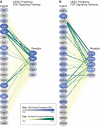Novel insights into embryonic stem cell self-renewal revealed through comparative human and mouse systems biology networks
- PMID: 24307629
- PMCID: PMC4404315
- DOI: 10.1002/stem.1612
Novel insights into embryonic stem cell self-renewal revealed through comparative human and mouse systems biology networks
Abstract
Embryonic stem cells (ESCs), characterized by their ability to both self-renew and differentiate into multiple cell lineages, are a powerful model for biomedical research and developmental biology. Human and mouse ESCs share many features, yet have distinctive aspects, including fundamental differences in the signaling pathways and cell cycle controls that support self-renewal. Here, we explore the molecular basis of human ESC self-renewal using Bayesian network machine learning to integrate cell-type-specific, high-throughput data for gene function discovery. We integrated high-throughput ESC data from 83 human studies (~1.8 million data points collected under 1,100 conditions) and 62 mouse studies (~2.4 million data points collected under 1,085 conditions) into separate human and mouse predictive networks focused on ESC self-renewal to analyze shared and distinct functional relationships among protein-coding gene orthologs. Computational evaluations show that these networks are highly accurate, literature validation confirms their biological relevance, and reverse transcriptase polymerase chain reaction (RT-PCR) validation supports our predictions. Our results reflect the importance of key regulatory genes known to be strongly associated with self-renewal and pluripotency in both species (e.g., POU5F1, SOX2, and NANOG), identify metabolic differences between species (e.g., threonine metabolism), clarify differences between human and mouse ESC developmental signaling pathways (e.g., leukemia inhibitory factor (LIF)-activated JAK/STAT in mouse; NODAL/ACTIVIN-A-activated fibroblast growth factor in human), and reveal many novel genes and pathways predicted to be functionally associated with self-renewal in each species. These interactive networks are available online at www.StemSight.org for stem cell researchers to develop new hypotheses, discover potential mechanisms involving sparsely annotated genes, and prioritize genes of interest for experimental validation.
Keywords: Biomathematical modeling; Cell signaling, Genomics; Computational biology; Embryonic stem cells; Pluripotent stem cells.
© 2013 AlphaMed Press.
Figures




Similar articles
-
Cell-type-specific predictive network yields novel insights into mouse embryonic stem cell self-renewal and cell fate.PLoS One. 2013;8(2):e56810. doi: 10.1371/journal.pone.0056810. Epub 2013 Feb 28. PLoS One. 2013. PMID: 23468881 Free PMC article.
-
Molecular basis of embryonic stem cell self-renewal: from signaling pathways to pluripotency network.Cell Mol Life Sci. 2015 May;72(9):1741-57. doi: 10.1007/s00018-015-1833-2. Epub 2015 Jan 17. Cell Mol Life Sci. 2015. PMID: 25595304 Free PMC article. Review.
-
Human foreskin fibroblast produces interleukin-6 to support derivation and self-renewal of mouse embryonic stem cells.Stem Cell Res Ther. 2012 Jul 31;3(4):29. doi: 10.1186/scrt120. Stem Cell Res Ther. 2012. PMID: 22849865 Free PMC article.
-
Evolutionarily conserved transcriptional co-expression guiding embryonic stem cell differentiation.PLoS One. 2008;3(10):e3406. doi: 10.1371/journal.pone.0003406. Epub 2008 Oct 15. PLoS One. 2008. PMID: 18923680 Free PMC article.
-
Genomic studies to explore self-renewal and differentiation properties of embryonic stem cells.Front Biosci. 2008 Jan 1;13:276-83. doi: 10.2741/2678. Front Biosci. 2008. PMID: 17981546 Review.
Cited by
-
Construction of Discrete Model of Human Pluripotency in Predicting Lineage-Specific Outcomes and Targeted Knockdowns of Essential Genes.Sci Rep. 2018 Jul 23;8(1):11031. doi: 10.1038/s41598-018-29480-w. Sci Rep. 2018. PMID: 30038409 Free PMC article.
-
Quantitative multivariate analysis of dynamic multicellular morphogenic trajectories.Integr Biol (Camb). 2015 Jul;7(7):825-33. doi: 10.1039/c5ib00072f. Integr Biol (Camb). 2015. PMID: 26095427 Free PMC article.
-
MMTR/Dmap1 Sets the Stage for Early Lineage Commitment of Embryonic Stem Cells by Crosstalk with PcG Proteins.Cells. 2020 May 11;9(5):1190. doi: 10.3390/cells9051190. Cells. 2020. PMID: 32403252 Free PMC article.
-
Expression of Oct3/4 and Nanog in the head and neck squamous carcinoma cells and its clinical implications for delayed neck metastasis in stage I/II oral tongue squamous cell carcinoma.BMC Cancer. 2015 Oct 19;15:730. doi: 10.1186/s12885-015-1732-9. BMC Cancer. 2015. PMID: 26483189 Free PMC article.
-
Adult Stem Cells and Diseases of Aging.J Clin Med. 2014 Jan 21;3(1):88-134. doi: 10.3390/jcm3010088. J Clin Med. 2014. PMID: 24757526 Free PMC article.
References
-
- Thomson JA, Itskovitz-Eldor J, Shapiro SS, Waknitz MA, Swiergiel JJ, Marshall VS, Jones JM. Embryonic stem cell lines derived from human blastocysts. Science. 1998;282(5391):1145–1147. - PubMed
-
- Gokhale PJ, Andrews PW. The development of pluripotent stem cells. Current opinion in genetics & development. 2012;22(5):403–408. - PubMed
-
- Ginis I, Luo Y, Miura T, Thies S, Brandenberger R, Gerecht-Nir S, Amit M, Hoke A, Carpenter MK, Itskovitz-Eldor J, et al. Differences between human and mouse embryonic stem cells. Developmental biology. 2004;269(2):360–380. - PubMed
-
- Brown S, Teo A, Pauklin S, Hannan N, Cho CH, Lim B, Vardy L, Dunn NR, Trotter M, Pedersen R, et al. Activin/Nodal signaling controls divergent transcriptional networks in human embryonic stem cells and in endoderm progenitors. Stem Cells. 2011;29(8):1176–1185. - PubMed
-
- Welling M, Geijsen N. Uncovering the true identity of naive pluripotent stem cells. Trends in cell biology. 2013 - PubMed
Publication types
MeSH terms
Grants and funding
LinkOut - more resources
Full Text Sources
Other Literature Sources
Research Materials

